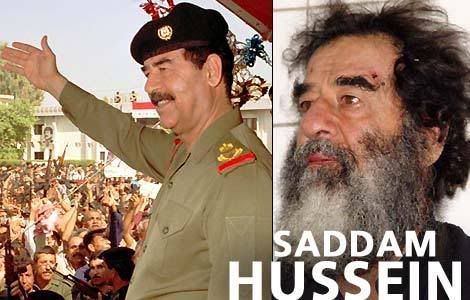
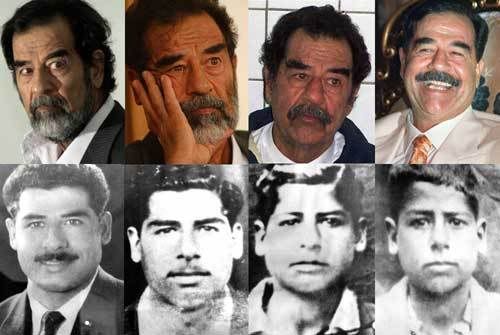
Saddam Hussein Abd al-Majid al-Tikriti 28 April 1937 – 30 December 2006) was the fifth President of Iraq and Chairman of the Iraqi Revolutionary Command Council from 1979 until his overthrow by US forces in 2003. He was executed after being found guilty of war crimes at his trial in 2006.
He was a member of the revolutionary Ba'ath Party, which espoused secular pan-Arabism, economic modernization, and Arab socialism. Saddam played a key role in the 1968 coup that brought the party to long-term power. As vice president under the ailing General Ahmed Hassan al-Bakr, Saddam tightly controlled conflict between the government and the armed forces—at a time when many other groups were considered capable of overthrowing the government—by creating repressive security forces. In the early 1970s, Saddam spearheaded Iraq's nationalization of the Western-owned Iraq Petroleum Company, which had long held a monopoly on the country's oil. Through the 1970s, Saddam cemented his authority over the apparatuses of government as Iraq's economy grew at a rapid pace.[1]
As president, Saddam maintained power through a combination of the skilful use of patronage and the employment of systematic state terror, aided by a pervasive security apparatus. Upwards of 200,000 people were estimated to have been killed or "disappeared" during his rule, and at least a million more were killed during the Iran-Iraq War (1980-1988) and the first Persian Gulf War (1991); he was dubbed the "Butcher of Baghdad" for the scale of bloodshed that he incurred[2] and reportedly embraced the nickname.[3] During and after these conflicts, Saddam used large-scale repression to crush rebellions he deemed threatening to the stability of Iraq, particularly Shi'a and Kurdish movements seeking to overthrow the government or gain independence, respectively. While he attracted support from the Arab public outside Iraq for opposing the United States and Israel,[4], the international community continued to view Saddam with deep suspicion following the 1991 Gulf War. Iraq remained subject to crippling international sanctions until the 2003 invasion of Iraq by the United States and its allies.
Deposed by the invasion, Saddam was captured by US forces on December 13, 2003 and was brought to trial under the newly-created Supreme Iraqi Criminal Tribunal. On November 5, 2006, he was convicted of charges related to the executions of 148 Iraqi Shi'ites as a collective punishment for an assassination attempt against him in the town of Dujail, and was sentenced to death by hanging. His execution was carried out on December 30, 2006.
http://en.wikipedia.org/wiki/Saddam_Hussein
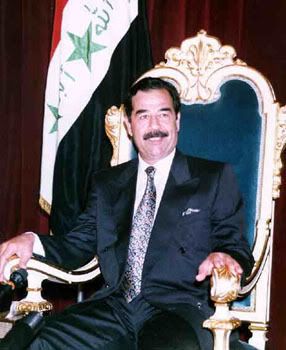
Saddam Hussein
http://history1900s.about.com/od/saddamhussein/p/saddamhussein.htm
Historical Importance: Saddam Hussein was the ruthless dictator of Iraq from 1979 until 2003.
Dates: April 28, 1937 -- December 30, 2006
Overview of Saddam Hussein: Saddam, which means "he who confronts," was born in a village called al-Auja, outside of Tikrit in northern Iraq. Either just before or just after his birth, his father disappeared from his life. Some accounts say that his father was killed; others say he abandoned his family.
Saddam's mother soon remarried a man who was illiterate, immoral, and brutal. Saddam hated living with his stepfather and as soon as his uncle Khairullah Tulfah (his mother's brother) was released from prison in 1947, Saddam insisted that he go and live with his uncle.
Saddam didn't start primary school until he moved in with his uncle at age 10. At age 18, Saddam graduated from primary school and applied to military school. Joining the military had been Saddam's dream and when he wasn't able to pass the entrance exam he was devastated. (Though Saddam was never in the military, he frequently wore military-style outfits later in life.)
Saddam then moved to Baghdad and started high school, but he found school boring and enjoyed politics more.
Saddam's uncle, an ardent Arab nationalist, introduced him to the world of politics. Iraq, which had been a British colony from the end of World War I until 1932, was bubbling with internal power struggles. One of the groups vying for power was the Baath Party, to which Saddam's uncle was a member.
In 1957, at age 20, Saddam joined the Baath Party. He started out as a low-ranking member of the Party responsible for leading his schoolmates in rioting. However, in 1959, he was chosen to be a member of an assassination squad. On October 7, 1959, Saddam and others attempted, but failed, to assassinate the prime minister. Wanted by the Iraqi government, Saddam was forced to flee. He lived in exile in Syria for three months and then moved to Egypt where he lived for three years.
In 1963, the Baath Party successfully overthrew the government and took power which allowed Saddam to return to Iraq from exile. While home, he married his cousin, Sajida Tulfah. However, the Baath Party was overthrown after only nine months in power and Saddam was arrested in 1964 after another coup attempt. He spent 18 months in prison, where he was tortured, before he escaped in July 1966.
During the next two years Saddam became an important leader within the Baath Party. In July 1968, when the Baath Party again gained power, Saddam was made vice-president.
Over the next decade, Saddam became increasingly powerful. On July 16, 1979, the president of Iraq resigned and Saddam officially took the position.
Saddam Hussein ruled Iraq with a brutal hand. He used fear and terror to stay in power.
From 1980 to 1988, Saddam led Iraq in a war against Iran which ended in a stalemate. Also during the 1980s, Saddam used chemical weapons against Kurds within Iraq, including gassing the Kurdish town of Halabja which killed 5,000 in March 1988.
In 1990, Saddam ordered Iraqi troops to take the country of Kuwait. In response, the United States defended Kuwait in the Persian Gulf War.
On March 19, 2003, the United States attacked Iraq. During the fighting, Saddam fled Baghdad. On December 13, 2003, U.S. forces found Saddam Hussein hiding in a hole in al-Dwar, near Tikrit.
After a trial, Saddam Hussein was sentenced to death for his crimes. On December 30, 2006, Saddam Hussein was executed by hanging.
Iraq timeline: July 16 1979 to January 31 2004
http://www.guardian.co.uk/Iraq/page/0,12438,793802,00.html
July 16 1979
Saddam Hussein becomes president of Iraq, after engineering the resignation of president Hasan al-Bakr.
Saddam Hussein's 'Official' Biography
http://usgovinfo.about.com/library/weekly/aasaddambio.htm
The Personal History of Saddam Hussein
http://www.emergency.com/hussein1.htm
Members of Saddam Hussein's family
http://en.wikipedia.org/wiki/Category:Members_of_Saddam_Hussein's_family
Saddam Hussein's Family Tree
http://www.pbs.org/frontlineworld/stories/iraq/family.html
Saddam Hussein's rise and fall
http://www.usatoday.com/news/world/iraq/saddam_timeline/flash.htm
Saddam Hussein
http://topics.nytimes.com/top/reference/timestopics/people/h/saddam_hussein/index.html
Fast Facts: Saddam Hussein
http://www.foxnews.com/story/0,2933,105708,00.html
BIRTH:
Born on April 27, 1937, in Tikrit, Iraq
WIVES:
Sajida Khairallah Telfah, who was also his cousin. Saddam's daughter Raghad says her father also married a woman from a prominent Iraqi family, Samira Shahbandar, who was his former mistress.
CHILDREN:
— By his first wife, two sons, Qusai (ku-SAY') and Odai (oh-DAY'), killed July 22, 2003 by U-S troops.
— Also by his first wife, three daughters: Raghad (RAH'-hahd) Saddam Hussein, Rana (RAH'-nah) Hussein and Hala Hussein.
— Two of Saddam's daughters were married to cousins of their father. Raghad married Hussein Kamal, and Rana married Saddam Kamel. In 1995, Saddam Hussein was angered when his sons-in-law and their wives defected to Jordan. They later returned to Iraq, believing they had been pardoned, but within 72 hours Saddam Hussein had both his sons-in-law killed. Raghdad, Rana, and their children were given sanctuary in Jordan in July of 2003.
— It is rumored that Saddam had a son, Ali, by his second wife. But Saddam's daughter Raghad denies this, saying those spreading the rumor mistake her own son, also named Ali, to be her father's.
TIMELINE:
1937 — Born in village of Uja near desert town of Tikrit, north of Baghdad.
1957 — Joins underground Baath Socialist Party.
1958 — Arrested for killing his brother-in-law, a communist; spends six months in prison.
Oct. 7, 1959 — On Baath assassination team that ambushes Iraqi strongman Gen. Abdel-Karim Kassem in Baghdad, wounding him. Saddam, wounded in leg, flees the country.
Feb. 8, 1963 — Returns from Egypt after Baath takes part in coup that overthrows and kills Kassem. Baath ousted by military in November.
July 17, 1968 — Baathists and army officers overthrow regime.
July 30, 1968 — Takes charge of internal security after Baath ousts erstwhile allies and authority passes to Revolutionary Command Council under Ahmed Hassan al-Bakr, Saddam's cousin.
July 16, 1979 — Takes over as president from al-Bakr, launches purge of Baath.
Sept. 22, 1980 — Sends forces into Iran; war last eight years.
March 28, 1988 — Uses chemical weapons against Kurdish town of Halabja, killing estimated 5,000 civilians.
Aug. 2, 1990 — Invades Kuwait.
Jan. 17, 1991 — Attacked by U.S.-led coalition; Kuwait liberated in a month.
March 1991 — Crushes Shiite revolt in south and Kurd revolt in north.
April 17, 1991 — Complying with U.N. Resolution 687, starts providing information on weapons of mass destruction, but accused of cheating.
Feb. 20, 1996 — Orders killing of two sons-in-law who in 1995 defected to Jordan and had just returned to Baghdad after receiving guarantees of safety.
Dec. 16, 1998 — U.N. weapons inspectors withdrawn from Iraq. Hours later, four days of U.S.-British air and missile strikes begin as punishment for lack of cooperation.
Nov. 8, 2002 — Threatened with "serious consequences" if he does not disarm in U.N. Security Council resolution.
Nov. 27, 2002 — Allows U.N. experts to begin work in Iraq for first time since 1998.
Dec. 7, 2002 — Delivers to United Nations declaration denying Iraq has weapons of mass destruction; later, United States says declaration is untruthful and United Nations says it is incomplete.
March 1, 2003 — United Arab Emirates, at an Arab League summit, becomes first Arab nation to propose publicly that Saddam step down.
March 7, 2003 — United States, Britain and Spain propose ordering Saddam to give up banned weapons by March 17 or face war; other nations led by France on polarized U.N. Security Council oppose any new resolution that would authorize military action.
March 17, 2003 — United States, Britain and Spain declare time for diplomacy over, withdraw proposed resolution. President Bush gives Saddam 48 hours to leave Iraq.
March 18, 2003 — Iraq's leadership rejects Bush's ultimatum.
March 20, 2003 — U.S. forces open war with military strike on Dora Farms, a target south of Baghdad where Saddam and his sons are said to be. Saddam appears on Iraqi television later in the day.
April 4, 2003 — Iraqi television shows video of Saddam walking in Baghdad.
April 7, 2003 — U.S. warplanes bomb a section of the Mansour district in Baghdad where Saddam and his sons were said to be meeting.
April 9, 2003 — Jubilant crowds greet U.S. troops in Baghdad, go on looting rampages, topple 40-foot statue of Saddam.
July 22, 2003 — Saddam's sons, Qusai and Odai, killed in gunbattle with U.S. troops.
July 31, 2003 — Two of Saddam's daughters, Raghad and Rana, and their nine children are given asylum in Jordan.
Nov. 16, 2003 — The last of nine tapes attributed to Saddam since his ouster is released. It tells Iraqis to step up their resistance to the U.S.-led occupation.
Dec. 13, 2003 — U.S. troops capture Saddam outside Tikrit.
June 30, 2004 — Saddam is transferred to Iraqi legal custody.
July 1, 2004 — Saddam is arraigned before a judge and defiantly rejects charges of war crimes and genocide.
December 30, 2006.-Execution

The life and times of Saddam Hussein
http://news.independent.co.uk/world/middle_east/article1956952.ece
Today's verdict marks the beginning of the final chapter in the controversial life story of the deposed dictator.
In an ironic twist, the tyrant has been forced to face trial for his crimes in front of the people he once ruled with an iron fist for more than 20 years.
The man who used fear and intimidation to cement his rule has spent the past three years as a prisoner himself, following his capture at the hands of the US Army in December 2003.
From the time he came to power in 1979, Saddam, lived and ruled by oppressing his people, building a reputation as one of the most reviled dictators of modern times,
His regime employed a ruthlessness that came with a burgeoning paranoia and an obsessive need for absolute control.
Because of it he became the world's most notorious and recognisable leader, his gun-toting, black-bereted moustachioed image visible everywhere.
Born on April 28, 1937, in the village of Al-Awja, near Tikrit, north of Baghdad, Saddam grew up in a peasant family.
His father died when he was a boy and his uncle Khayrallah took the young Saddam under his wing.
He reportedly could not read by the age of 10 but it was his uncle, an army officer and Arab nationalist, who encouraged his education.
But the young loner did not plan on earning respect through academic diligence. He was already learning other skills that would become more important in his later life.
As part of the al-Khatab clan, an extended family noted for its cunning and violence, he reportedly earned the respect of those around him in a way that would impress his clan - by shooting and trying to kill the teacher who beat him at school.
It was during these days that the young Saddam used to go fishing with dynamite, and reportedly all he wanted when he grew up was a "Jeep, a hunting rifle and a pair of binoculars".
Saddam joined the fledgling Arab Socialist Baath or Renaissance Party in 1957, and a year later he played a part in the attempted assassination of a supporter of Iraqi ruler Abdul-Karim Qassim.
By this time he had become a trusted member of the Baath party, and took his place at the top table when it swept to power in the 1960s.
After achieving power in 1979, he proved himself willing to go to any lengths to retain his position.
As the years went by, Saddam became increasingly distrustful.
He kept the soldiers of the 1st Battalion of the 1st Brigade Special Republican Guard around him, ready to take a bullet for their leader and more importantly, the Amn al-Khas, the Special Security Service.
In case all else failed, Saddam kept a pistol stuffed in his belt.
During his tenure as leader, Saddam developed a careful security regime, moving daily among his 24 palaces to avoid being attacked by enemies inside and outside his state.
He built up a complex system of underground bunkers, and used a number of lookalikes to confuse potential assassins.
Despite his tight security measures, Saddam still enjoyed an opulent lifestyle.
He had alcohol, fresh steaks and seafood flown in twice a week, and liked wine with meals.
But he was careful not to let anyone outside his most trusted circle of family and aides see him drinking, as alcohol is forbidden by Islam.
At 6ft 2ins he was tall for an Arab and had a tattoo of three small blue dots on his right hand, given to village children when they are young.
He also tended towards vanity, dyeing his hair black and avoiding using his reading glasses in public. Aides printed his speeches in huge letters, just a few lines per page.
One of his most enduring relationships was with his wife, Sajida, daughter of his mentor uncle, to whom he has been married for around 40 years.
She bore him two sons, Qusay and Uday, who were killed in a gun battle with US troops in July 2003, and three daughters.
As president, Saddam spent little time visiting his people, preferring to study reports from his secret police, or meet high officials.
Occasionally he would visit workers in factories but was so used to being told what he wanted to hear from frightened ministers that he only saw what he wanted to see.
In recent years the dictator wrote and published romantic fables, including Zabibah and The King And The Fortified Castle and, his latest book, Men And A City, sold well in Baghdad bookshops to war.
The coalition's war against the dictator dealt a fatal blow, not only to his regime, but also to his fragile vanity and the place in history he so coveted.
One of the iconic images from the conflict was the destruction of a giant statue of Saddam in Baghdad.
Aided by Allied troops, Iraqis brought down the towering effigy, dancing and cheering as it collapsed.
From that moment, the balance of power shifted, and Saddam's shadow was finally lifted from the country he had ruled for so long.
Here are key dates in the rise and fall of Saddam Hussein.
April 28, 1937: Saddam is born in the village of Uja near Tikrit, north of Baghdad.
1957: Saddam joins the underground Baath Socialist Party.
1958: He is arrested for killing his brother-in-law, a Communist, and spends six months in jail.
1959: He flees the country with a wounded leg after taking part in an ambush in Baghdad.
1963: He returns from Egypt.
1968: Baathists and army officers overthrow the regime. Saddam takes charge of internal security and authority passes to Revolutionary Command Council under Ahmed Hassan al-Bakr, his cousin.
July 16, 1979: Saddam takes over as president from al-Bakr, and launches massive purge of Baath.
September 22, 1980: He sends forces into Iran, sparking a war which lasts for eight years.
March 28, 1988: He uses chemical weapons against Kurdish town of Halabja, killing an estimated 5,000 civilians.
August 2, 1990: Saddam invades Kuwait.
January 17, 1991: He is attacked by a US-led coalition and Kuwait is liberated in a month.
March, 1991: He crushes a Shiite revolt in south and a Kurd revolt in north.
April 17, 1991: Complying with a UN Resolution, he starts providing information on weapons of mass destruction, but is accused of cheating.
February 20, 1996: He orders the killing of two sons-in-law who defected to Jordan and had just returned to Baghdad after receiving guarantees of safety.
December 16, 1998: Weapons inspectors are withdrawn from Iraq. Hours later, four days of US-British air and missile strikes begin, following a lack of co-operation.
November 8, 2002: Saddam is threatened with "serious consequences" if he does not disarm in a UN Security Council resolution.
March 17, 2003: United States, Britain and Spain declare the time for diplomacy as over and President Bush gives Saddam 48 hours to leave Iraq.
March 20, 2003: American forces launch war with military strike on Dora Farms, a target south of Baghdad where Saddam and his sons are said to be.
April 7, 2003: A section of the Mansour district in Baghdad where Saddam and his sons were said to be meeting, is bombed.
April 9, 2003: Crowds greet US troops in Baghdad, go on looting rampages and topple 40-foot statue of Saddam.
July 22, 2003: Saddam's sons, Qusai and Odai are killed. American forces then raid the northern city of Mosul and later say they missed Saddam "by a matter of hours".
December 13, 2003: Saddam is captured in the town of Adwar, near Tikrit, hiding in a "spider hole".
June 30, 2004: Saddam is transferred to Iraqi legal custody.
July 1, 2004: Saddam and regime figures appear in court to hear criminal charges. Charges of war crimes and genocide are defiantly rejected. Saddam says: "This is all theatre, the real criminal is Bush".
December 17, 2004: Saddam sees an Iraqi lawyer for first time since capture.
June 13, 2005: He is shown in a video being questioned about the 1982 massacre in Dujail, where nearly 150 Shiite Muslims were killed after an assassination bid against the president.
October 19, 2005: A trial begins, with Saddam challenging the court's legitimacy.
October 20, 2005: Masked gunmen kidnap defence attorney Saadoun al-Janabi after he leaves his Baghdad office. His body is found the next day with bullet holes in the head.
November 8, 2005: Defence lawyer Adel al-Zubeidi is killed in a Baghdad ambush and a colleague, Thamir al-Khuzaie, is wounded. Al-Khuzaie flees the country.
November 28, 2005: The trial reconvenes after five-week recess, and Saddam calls Americans "occupiers and invaders". He and two other defendants complain about treatment by their US captors.
December 4, 2005: One of the five judges steps down after learning that a Saddam co-defendant may have been involved in his brother's execution.
December 5, 2005: Defence lawyers walk out when denied right to challenge court's legitimacy; chief judge then reverses ruling and allows former US Attorney, General Ramsey Clark, a member of Saddam's defence team, to speak.
December 7, 2005: Saddam refuses to attend, a day after shouting: "I will not come to an unjust court! Go to hell!"
December 21, 2005: Saddam claims Americans beat and tortured him and other defendants, and prays openly in court despite judge's order for trial to proceed.
January 15, 2006: Chief judge Rizgar Amin, a Kurd, resigns after complaints by Shiite politicians that he had failed to keep control of court proceedings.
January 23, 2006: Court officials name Raouf Abdul-Rahman, another Kurd, to replace Amin.
June 21, 2006: Defence lawyer Khamis al-Obeidi is abducted and slain.
July 7, 2006: Saddam and three others refuse food to protest lack of security for lawyers and conduct of the trial.
July 23, 2006: Saddam is taken to hospital on the 17th day of his hunger strike and fed through a tube.
July 27, 2006: The Dujail trial adjourns.
November 4, 2006: Iraq's prime minister Nouri Maliki says he hopes the former leader would be given "what he deserves".
November 5, 2006: Saddam is convicted of crimes against humanity by the court in Baghdad. He is sentenced to death by hanging. Baghdad's international airport is closed until further notice, part of an open-ended curfew in the capital and two neighbouring provinces designed to head-off a feared outbreak of violence.
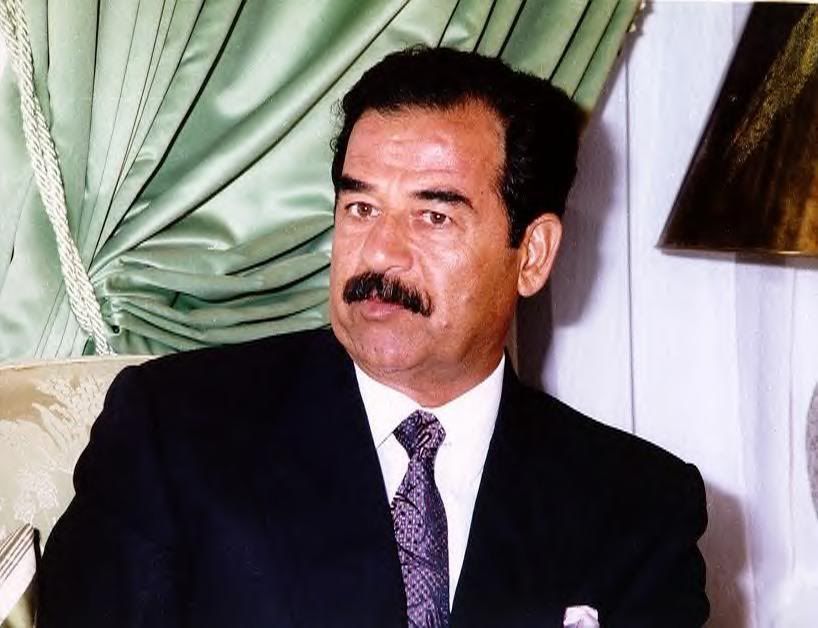
Saddam Hussein
http://www.globalsecurity.org/military/world/iraq/saddam.htm
President of Iraq since 1979 (Vice President from 1968-79), Saddam Hussein [Husayn] was a dictator who stopped at nothing to preserve personal power and regime survival. After the 1968 Ba'athist Coup, he began his career as Chief of Iraq's security services, and he executed opponents and suspected potential rivals, including scores of high-level government officials and thousands of political prisoners. Since the 1970s, he escalated and made routine the systematic torture and execution of political prisoners. Saddam Hussein ordered the use of chemical weapons against Iranian forces in the 1980-88 Iran-Iraq war, and against Iraq's Kurdish population in 1988. The 1980-88 Iran-Iraq war left 150,000 to 340,000 Iraqis and 450,000 to 730,000 Iranians dead. Saddam Hussein ordered the invasion and destruction of Kuwait in 1990-91 with 1,000 Kuwaitis killed. Directed the 1991 bloody suppression of Kurdish and Shi'a insurgencies in northern and southern Iraq with at least 30,000 to 60,000 killed. he later ordered the destruction of southern marshes to extinguish the Shi'a insurgency.
Saddam was born in 1937, and reared in a mud hut near Tikrit, north of Baghdad. From the age of ten, Saddam was reared by an uncle, who encouraged him to dream of becoming a nationalist Arab hero, like Saladin. The chief influences during Hussein's childhood and teenage years were his mother and his uncle Khairullah Tulfah. Tulfah, an Iraqi army officer who introduced Hussein to the evils of colonialism in Iraq, was imprisoned by the British for his activism against the English-backed monarchy of King Feisal I.
The Baath (renaissance) Party, which Muslim Salah Bitar and Christian Michel Aflaq originally established, became a vehicle for Hussein. He became an enforcer for the party, and like Joseph Stalin, who fascinated Hussein, he left the intellectuals behind and climbed the ladder of Iraq politics, using a combination of intimidation, fear, nepotism, and outright murder.
In 1958, Feisal's monarchy came to a bloody end, and General Adel Karim Kasim took power. A year later, Hussein participated in a failed attempt on Kasim's life. Hussein was exiled to Egypt, where he became enamored of President Gamal abd-al-Nasser, who espoused Arab nationalism. Hussein was also instrumental in organizing Baath cells at the University of Cairo. In 1963, General Abdel-Rahman Arif overthrew Kasim, and the Baaths were in power.
By 1968 close family and tribal ties bound the Baath's ruling clique. Most notable in this regard was the emergence of Tikritis -- Sunni Arabs from the northwest town of Tikrit -- related to Ahmad Hasan al Bakr. Three of the five members of the Baath's Revolutionary Command Council (RCC) were Tikritis; two, Bakr and Hammad Shihab, were related to each other. The cabinet posts of president, prime minister, and defense minister went to Tikritis. Saddam Hussein [Husayn], a key leader behind the scenes, also was a Tikriti and a relative of Bakr. Less than two months after the formation of the Bakr government in 1968, a coalition of pro-Nasser elements, Arif supporters, and conservatives from the military attempted another coup. This event provided the rationale for numerous purges directed by Bakr and Saddam Husayn.
Saddam Hussein was a consummate party politician whose formative experiences were in organizing clandestine opposition activity. He was adept at outmaneuvering -- and at times ruthlessly eliminating -- political opponents. Although Bakr was the older and more prestigious of the two, by 1969 Saddam Hussein clearly had become the moving force behind the party. He personally directed Baathist attempts to settle the Kurdish question and he organized the party's institutional structure. Hussein was put into control of the internal security apparatus, and within a decade, he had created a police state within Iraq that was so oppressive that it has often received criticism from moderate Arab states. Between 1968 and 1973, through a series of sham trials, executions, assassinations, and intimidations, the party ruthlessly eliminated any group or person suspected of challenging Baath rule.
Despite Baath attempts to institutionalize its rule, real power remained in the hands of a narrowly based elite, united by close family and tribal ties. By 1977 the most powerful men in the Baath thus were all somehow related to the triumvirate of Saddam Hussein, Bakr, and General Adnan Khayr Allah Talfah, Saddam Hussein's brother-in-law who became minister of defense in 1978. All were members of the party, the RCC, and the cabinet, and all were members of the Talfah family of Tikrit, headed by Khayr Allah Talfah. Khayr Allah Talfah was Saddam Hussein's uncle and guardian, Adnan Khayr Allah's father, and Bakr's cousin. Saddam Hussein was married to Adnan Khayr Allah's sister and Adnan Khayr Allah was married to Bakr's daughter. Increasingly, the most sensitive military posts were going to the Tikritis.
Beginning in the mid-1970s, Bakr was beset by illness and by a series of family tragedies. He increasingly turned over power to Saddam Husayn. By 1977 the party bureaus, the intelligence mechanisms, and even ministers who, according to the Provisional Constitution, should have reported to Bakr, reported to Saddam Hussein. Saddam Hussein, meanwhile, was less inclined to share power, and he viewed the cabinet and the RCC as rubber stamps. On July 16, 1979, President Bakr resigned, and Saddam Hussein officially replaced him as president of the republic, secretary general of the Baath Party Regional Command, chairman of the RCC, and commander in chief of the armed forces. On July 17, 1979, he was promoted to the rank of Field Marshal.
Saddam has been married to the same woman, former schoolteacher Sajida, since 1958. She has been described as a first cousin, not unusual for Mideast marriages of that era. They have five children, three daughters and two sons.
Saddam Hussein was captured by forces from the 4th Infantry Division, coalition forces and special operations forces at approximately 8 p.m. local time on December 13, 2003, in a remote farm house near Tikrit, Iraq.

Iraq Under Saddam - A Documentary
Saddam Hussein profile
http://news.bbc.co.uk/1/hi/world/middle_east/1100529.stm
Saddam Hussein, President of Iraq for the past two decades, has the dubious distinction of being the world's best known and most hated Arab leader.
And in a region where despotic rule is the norm, he is more feared by his own people than any other head of state.
A former Iraqi diplomat living in exile summed up Saddam's rule in one sentence: "Saddam is a dictator who is ready to sacrifice his country, just so long as he can remain on his throne in Baghdad." Few Iraqis would disagree with this. Although none living in Iraq would dare to say so publicly.
The Iraqi people are forced to consume a daily diet of triumphalist slogans, fattened by fawning praise of the president.
He is portrayed as a valiant knight leading the Arabs into battle against the infidel, or as an eighth-century caliph who founded the city of Baghdad. Evoking the glory of Arab history, Saddam claims to be leading his people to new glory.
The reality looks very different. Iraq is bankrupt, its economy and infrastructure shattered by years of economic sanctions imposed by the United Nations following the invasion of Kuwait.
Saddam Hussein remains largely isolated from his people, keeping the company of a diminishing circle of trusted advisers - largely drawn from his close family or from the extended clan based around the town of Takrit, north of Baghdad.
The path to power
The Iraqi president was born in a village just outside Takrit in April 1937. In his teenage years, he immersed himself in the anti-British and anti-Western atmosphere of the day. At college in Baghdad he joined the Baath party.
After the overthrow of the monarchy in 1958, Saddam connived in a plot to kill the prime minister, Abdel-Karim Qassem. But the conspiracy was discovered, and Saddam fled the country.
In 1963, with the Baath party in control in Baghdad, Saddam Hussein returned home and began jostling for a position of influence. During this period he married his cousin Sajida. They later had two sons and three daughters.
But within months, the Baath party had been overthrown and he was jailed, remaining there until the party returned to power in a coup in July 1968. Showing ruthless determination that was to become a hallmark of his leadership, Saddam Hussein gained a position on the ruling Revolutionary Command Council.
For years he was the power behind the ailing figure of the president, Ahmed Hassan Bakr. In 1979, he achieved his ambition of becoming head of state. The new president started as he intended to go on - putting to death dozens of his rivals.
Holding together a disparate nation
President Saddam Hussein might defend his autocratic style of leadership by arguing that nothing else could have kept such a vast and diverse nation united.
And, for all that Saddam Hussein is criticised and reviled, his opponents have not been able to nominate anyone else who might hold Iraq together - with its Kurds in the north, Sunni Muslims in the centre and Shi'ia in the south. What the outside world calls terror, Saddam calls expediency.
Some years ago a European interviewer nervously quoted reports that the Baghdad authorities might, on occasions, have tortured and perhaps even killed opponents of the regime.
Was this true? Saddam Hussein was not offended. Rather, he seemed surprised by the naivete of the question. "Of course," he replied. "What do you expect if they oppose the regime?"
But his tactic of imposing his authority by terror has gone far beyond the occasional arrest and execution of opponents. In attempts to suppress the Kurds, for example, he has systematically used chemical weapons. And in putting down a rebellion of Shi'ia in the south he has razed towns to the ground and drained marshland.
Not that you would recognise the figure of a tyrant in the portraits that adorn every building and street corner in Iraq.
Here you see Saddam, usually smiling benevolently, in a variety of guises and poses - in military uniform, say, or in traditional ethnic dress, or tweed cap and sports jacket; he might be surrounded by his family or be seen jiggling a young child on his knee - the would-be father-figure of the Iraqi nation.
A question of judgement
The fiction of Saddam Hussein as a benevolent ruler was exposed by two major and catastrophic miscalculations of foreign policy for which his country and his people have paid dearly.
In 1980, Saddam thought he saw an opportunity for glory - to put Iraq at the forefront of the Arab world. He ordered a surprise cross-border attack on Iran. This was meant to be a swift operation to capture the Shatt al-Arab waterway leading to the Gulf.
But Iranian resistance was far stronger than he had imagined. Eight years later, with hundreds of thousands of young people killed and the country deep in debt, he agreed on a ceasefire.
Still, with enormous oil reserves, Iraq seemed to have the potential to make a swift recovery. An increase in oil prices, Saddam Hussein surmised, would speed up the country's revival still more.
Frustrated by his failure to achieve agreement on a price rise by conventional means, the Iraqi president allowed his long-harboured resentment against Kuwait to get the better of him.
On 2 August 1990, he made another costly blunder by ordering his army into the neighbouring Gulf state.
Fighting qualities
In the months that led up to the war of 1991, Saddam Hussein displayed qualities that still make him both adored and hated in the Arab world.
On the streets of Arab cities he is admired as a leader who has dared to defy and challenge Israel and the West, a symbol of Arab steadfastness in the face of Western aggression.
At the same time, Saddam is feared as a vicious dictator who threatens the security of the Gulf region as a whole.
With his older and favourite son Uday crippled in an assassination attempt, his younger son Qusay now controls the elite Revolutionary Guards and the Special Forces which guarantee the president's grip on power.
Gulf states and Western countries alike have come to realise that his grip is stronger than it seems - and stronger by far than his grasp of reality often appears to be.
He insists that the 1991 Gulf War, which he famously described as the Mother-of-All-Battles, ended in victory for Iraq.
By the same token, Saddam boasts that Iraq can shrug off any Western military attack. The Iraqi people have no choice but to nod in agreement.
So it will go on until the moment comes for bombastic slogans to be replaced by a succinct epitaph to one of the most infamous dictators of the century. For the overwhelming majority of Iraqis, that moment can not come too soon.
The Hussein Family




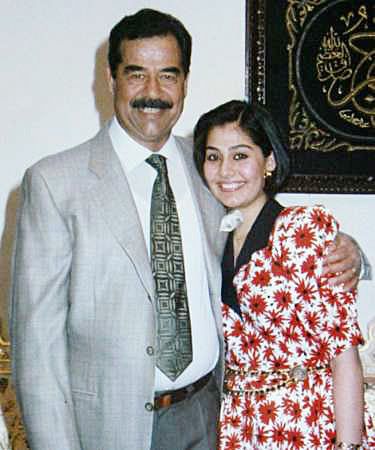
Daughter: Saddam 'had a big heart'
Two of his children describe regime's end
http://www.cnn.com/2003/WORLD/meast/08/01/sprj.irq.saddam.daughters/index.html
AMMAN, Jordan (CNN) -- With tears in their eyes, Saddam Hussein's two oldest daughters said Friday that they still love their father but wouldn't talk about his role in the deaths of their husbands in 1996.
Speaking from exile in Amman, 35-year-old Raghad Hussein and 33-year-old Rana Hussein also told CNN that they don't know where the former president has been hiding since the U.S.-led war that ousted his regime from power. They last spoke to Saddam seven days before the war, which started March 19.
"He was a very good father, loving, had a big heart, loved his daughters, sons, grandchildren," Raghad said. "He was the one we always go to."
Rana, who spoke in Arabic, also talked of her father.
"I pray to God that he will be fine and safe," she said.
Recently, the sisters and their nine children fled to Amman, where they were welcomed as guests of King Abdullah II. In 1995, the sisters and their husbands -- who were brothers -- were welcomed by Abdullah's father, King Hussein.
Six months after they defected, they were lured back to Iraq by when Saddam promised forgiveness. Once they arrived, the men were killed in a shootout in a house near Baghdad. The shootout was believed to have been organized by Rana and Raghad's brothers, Uday and Qusay, at their father's request.
Uday and Qusay were killed in a shootout with U.S. troops this month at a house in Mosul.
The sisters said they chose Jordan because of the previous trip there.
Raghad said the decision to leave other family members and friends in Iraq was "horrible."
"Everybody was hugging each other," she said.
A younger sister, Hala, remains in Iraq. Saddam's three daughters and two sons are those of his first wife, Sajida Khairallah Telfah.
The sisters declined to describe any angry feelings they might have against their father for leaving them widows, noting his current situation, and also refused to talk about their brothers' deaths.
"Our wounds are deep," Rana said when the two were asked about Saddam's role in the deaths of their husbands.
The sisters said they hope to see their father again, even as U.S. troops hunt for him.
"I hope we can start a new life with our kids and each other," Raghad said. "Now I can feel I'm home."
The women, both dressed in black dresses and white veils, are staying at an undisclosed location in Amman and said they don't expect to return to Iraq for a long time. They said they hope to live in Jordan the rest of their lives.
Earlier Friday, Raghad said her father's regime collapsed because people close to him betrayed him, and she expressed negative feelings for Saddam.
"Unfortunately, people who my father trusted absolutely have failed him, have betrayed him," she told the Arabic-language network Al Arabiya. Without naming names, she said her father also felt he had been sold out.
"Even if I don't like him, in human terms, we should not betray a person. It is not in the Arab honor," she said.
"They have betrayed their country, they have betrayed Saddam Hussein, my father," she said. "They are men and they should not have given up so easily."
Fall of Baghdad 'a great shock'
She said the rapid fall of Baghdad -- in about two days -- was "a great shock."
The U.S.-led attack on two fronts began March 19, and President Bush declared major combat over May 1.
Raghad said once she realized the Iraqi army's defeat, "I had to go to my sister to tell her that the situation has now ended completely, but she did not believe that all was lost."
Her father sent a car with a security brigade to move his daughters and their children.
"We left Baghdad. We met our mother a few hours later. They placed us in a house in the extreme suburbs of Baghdad. Then, the situation was out of control," she said, adding that she was armed with a rifle.
"Rockets were falling all over the place, sometimes about 50 meters from where we were. Because of the intensity of the bombing, the house was shaking," Raghad said.
"I told my mother also that everything is lost. We are all women together, and we have to decide what to do next," she said. Her mother advised the group to split up.
"From that moment on, I did not see my mother."
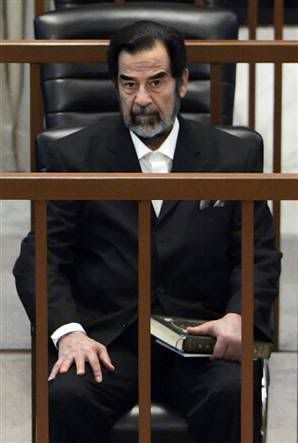
Trial of Saddam Hussein
Saddam Hussein (April 28, 1937 - December 30, 2006), the former President of Iraq, was tried by the interim Iraqi government for crimes against humanity.
The Coalition Provisional Authority voted to create the Iraqi Special Tribunal (IST), consisting of five Iraqi judges, on December 9, 2003, to try Saddam Hussein and his aides for charges of war crimes, crimes against humanity, and genocide.[1] Saddam was captured on December 13, 2003.[2]
The IST statute was reaffirmed by the Iraqi interim government when power was transferred to Iraqis in July 2004.[3] Hussein remained in custody by U.S. forces at Camp Cropper in Baghdad, along with eleven senior Ba'athist officials. Particular attention would be paid to alleged activities in violent campaigns against the Kurds in the north during the Iran-Iraq War, against the Shiites in the south in 1991 and 1999 to put down revolts, and in Dujail after a failed assassination attempt on 8 July in 1982 during the Iran-Iraq war. Saddam asserted in his defense that he had been unlawfully overthrown, and was still the president of Iraq.
On December 6th, 2006, Saddam Hussein appeared in court for the last time.[2] In the first place he did not want to appear, the trial was post-poned for one hour, finally Saddam appeared, he did not say much. He only questioned one witness, stating the prosecution made up those witnesses and coerced the witnesses to lie for the new U.S. backed government.
The first trial of Saddam Hussein began before the Iraqi Special Tribunal on October 19, 2005. In this case Hussein and seven other defendants were tried for allegations of crimes against humanity with regard to events that took place after a failed assassination attempt in Dujail in 1982 by members of the Islamic Dawa Party (see also human rights abuses in Iraq). On November 5, 2006, Saddam was sentenced to death by hanging. On December 26, Saddam's appeal was rejected and the death sentence upheld. No further appeals were taken and Saddam was ordered executed within 30 days of that date. The date and place of the execution was secret until the sentence was carried out.[4]
A second and separate trial began August 21, 2006 [3], trying Saddam and six co-defendants for genocide during the Anfal military campaign against the Kurds of northern Iraq. Saddam may also have been tried in absentia for events dating to the Iran-Iraq War and the Invasion of Kuwait, including war crimes, crimes against humanity, and genocide. With his death all other more important charges have been dropped.
On December 30, 2006 the U.S. backed Al Hurra TV station reported that Saddam Hussein was executed by hanging at 6:05 AM local time (0305 UTC). He was legally pronounced dead at 6:10.[4] At 0325 UTC Labeed Abbawi, the Iraqi Deputy Foreign Minister, confirmed Saddam's execution to BBC News. Saddam was scheduled to hang in the morning of December 28th 2006, however due to u.s. legal proceedings, the date was moved[5][6] [7] to December 30th, the Eid Holiday, (Sunni) Muslim Day of Sacrifice. Saddam was buried at 03:00 AM near his home village of Tikrit
http://en.wikipedia.org/wiki/Trials_of_Saddam_Hussein
Timeline: Saddam Hussein Dujail trial
Saddam Hussein and seven different defendants were put on trial for the killing of 148 Shias in Dujail in 1982. Here is a day-by-day account of the trial, summarising the key evidence, events and sentences.
http://news.bbc.co.uk/2/hi/middle_east/4507568.stm
Saddam Hussein on Trial
http://www.courttv.com/trials/saddam/
Saddam Hussein verdict
Saddam Hussein Sentenced to Death By Hanging
Saddam Hussein executed asıldı Hüseyin idam
Saddam Hussein - The Trial you will never see
Saddam Hussein hanged
http://www.cnn.com/SPECIALS/2005/saddam.trial/
Saddam Hussein executed, ending era in Iraq
Iraqis cheer after deposed dictator hanged for 148 Shiite deaths in 1982
http://www.msnbc.msn.com/id/16389128/
BAGHDAD, Iraq - Saddam Hussein struggled briefly after American military guards handed him over to Iraqi executioners before dawn Saturday. But as his final moments approached and masked executioners slipped a black cloth and noose around his neck, he grew calm.
In a final moment of defiance, he refused a hood to cover his eyes.
Hours after Saddam faced the same fate he was accused of inflicting on countless thousands during a quarter-century of ruthless power, Iraqi state television showed grainy video of what it said was his body, the head uncovered and the neck twisted at a sharp angle.
Witnesses to the execution told NBC News’ Richard Engel that they were cheering around the body of Saddam after the hanging — three years after the deposed president was hauled from a hole in the ground by pursuing U.S. forces.
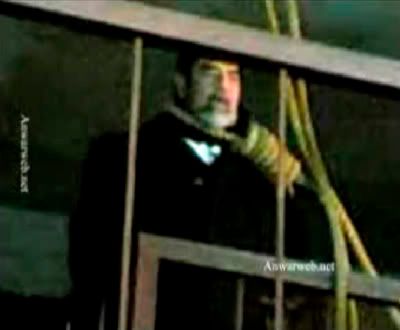
Saddam Hussein Is Dead
http://www.time.com/time/world/article/0,8599,1573255,00.html
Saddam Hussein may have lost his life today. But he really died on Dec. 13, 2003. That was the day he was found by U.S. forces, hiding in a hole on a relative's farm outside his hometown of Tikrit. No one in Iraq had ever seen him more vulnerable. There he was, shown on television, dirt smeared on his face, his beard unkempt, his thick head of hair matted and graying. I watched these scenes unfold in Baghdad with my friend Omar, who chuckled when he saw a doctor shining a flashlight in Saddam's open mouth. It reminded him of a trader checking the teeth of a new donkey, he said. Was this the same man who had been beamed into Iraqi living rooms for hours on end, delivering speeches in a pressed uniform, his hair smartly dyed black, his mustache full and neat? Was this the man who took on Iran? The man who lobbed rockets at Israel and threatened the President of the United States? Was this the man the country's composers wrote songs for? At that moment, all the artifice and cunning Saddam had invested in his 24 years at the levers of power fell away and the shepherd's son who had his name stamped on the bricks at Babylon was shown to be that last and most pathetic thing every dictator who lives long enough inevitably becomes: a frightened old man, totally alone.
The man who saw himself as a modern heir to Mesopotamian kings like Nebuchadnezzar and Hammurabi was born on April 28, 1937, on the banks of the Tigris in the hardscrabble village of Owja, just south of Tikrit. Saddam never knew his father, a shepherd, who disappeared six months before he was born. He was raised alternately by his mother and his uncle, a fervent Iraqi nationalist and an early supporter of the Iraqi Baath party who had an early ideological influence on the ambitious young Saddam. It may have influenced his mother's choice of a name for the child: Saddam means "he who confronts."
Saddam joined the pan-Arab nationalist Baath Party in 1957. Two years later, at the age of 22, Saddam was part of a Baathist plot to assassinate General Abdul Karim Kassem, who had overthrown the monarchy of King Faisal II a year before. Saddam escaped Iraq with a gunshot wound in the leg and spent the next six years in exile in Cairo where he had contacts with the CIA. The American spy agency was backing the Baathists at the time.
When the Baath Party took power in Iraq in 1968, Saddam was named Vice President to the aging General Ahmed Hassan al-Bakr and spent the next 11 years mastering the way the regime worked and consolidating his own power and popular support. He launched a popular literacy campaign across Iraq and made education more accessible. He modernized the health system and helped al-Bakr mastermind the nationalization of Iraq's oil resources, seizing petroleum rights from international companies. He also was instrumental in building up the Baath Party's all-pervasive network of informants to ensure loyalty and warn of coup plots. However, in 1979, when Al-Bakr proposed a federation with the neighboring Baathist regime of Syria, an agreement in which Syrian President Hafez Assad would become the heir apparent to a united Syria-Iraqi Baathist republic, Saddam acted. Al-Bakr was thrust out of office and Saddam assumed the presidency. In a single day, he had 68 Baath Party members arrested for disloyalty, 22 of whom were later hanged for treason.
As much as he knew how to manipulate power in Iraq through propaganda and government-sponsored terror, he was inept at international relations and diplomacy. His enemies abroad were myriad. Certainly, he and Assad's regime in Damascus were not friendly, despite the political genetics that linked their ruling parties. But he was also an enemy of Ayatullah Ruhollah Khomeini, the Iranian cleric who had fled the Shah's persecution and sought refuge in Iraq's holy Shi'a city of Najaf in 1965. Saddam did not make it a comfortable stay and Khomeini moved on to exile in Europe. When the Ayatollah became the supreme leader of Iran's Islamic revolutionary government in 1979, a clash was inevitable. In 1980, Saddam ordered the invasion of a southern province of Iran, sparking an eight-year war of attrition that ended in stalemate and the deaths of more than a million on both sides.
Even if Washington was happy to see Khomeini's Iran bogged down in a proxy war with Saddam's forces, the Iraqi dictator quickly disabused anyone who believed that he was the strongman to guarantee Middle East stability. In 1990, just three years after the costly Iran-Iraq war ground to a halt, Saddam, having built up one of the largest militaries in the region, decided to resolve tensions with Kuwait over oil rights and boundary lines by invading. But he underestimated the response from the international community and a U.S.-led multinational force routed his tank divisions. From 1991 until the U.S. invasion of March 2003, Iraq was under international sanctions and U.S. F-16s patrolled "no fly zones" in large portions of its northern and southern regions.
The second Gulf War drove Saddam from Baghdad and power and into the spider hole. In the interim, his Baathist apparatus and military were dismantled. His family dispersed. His heirs, the despicable Uday and Qusay, were killed while fugitives in Iraq. Two years after his arrest, Saddam was put on trial for war crimes before the newly re-constituted Iraqi High Tribunal. In November he was convicted of genocide for ordering the executions of 148 men and boys in response to a 1982 assassination attempt in the town of Dujail. The Dujail trial introduced witnesses and an extensive document trail that proved Saddam's personal hand in the collective punishment that followed the attempt on his life. His death comes in the middle of another trial that had Saddam and other key figures from his regime facing charges of launching chemical attacks against tens of thousands of Kurds in the late '80s. That trial will continue without Saddam as a defendant.
It is fitting that Saddam Hussein died, as many of his political opponents did, dangling from the end of a rope. He had used the gallows at Abu Ghraib to silence opposition and dissent. In doing so, he had controlled Iraq for over two decades, but he created a generation of enemies. And some of those enemies, who never forgot their fathers and brothers who disappeared in the night, were there to watch him die.
For many who watched it, the execution of Saddam Hussein was a personal vindication. He killed their brothers, uncles, tore apart their families and ran their beloved country into the ground. Even if his finger didn't pull the trigger, they blamed him for everything: every nail-biting visit by an intelligence officer, every midnight execution, every tongue cut out by a sadistic guard, every body in the mass graves at Hillah and Hawija and Musayeb. He projected absolute authority while he was in power and now faced absolute responsibility for every death under his rule. The moment the steel trap door below his feet was released, he suffered the absolute punishment — a powerless old man, dying alone.
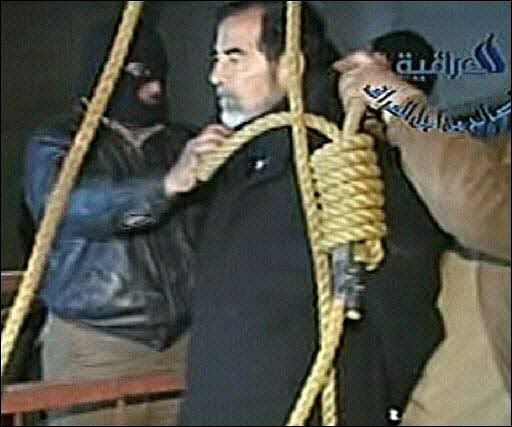
Saddam Hussein executed
Saddam Hussein executed in Iraq
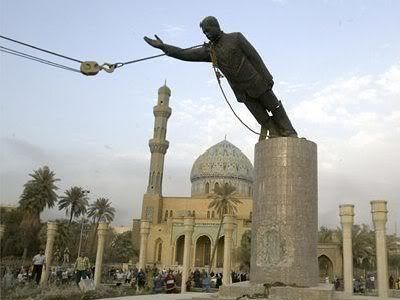
Iraq After Hussein
Saddam Hussein in Iraq Tv Last Day
A Day before the Fall of the Regime Saddam on TV
1990 CNN interview with Saddam Hussein talking about death
Saddam Hussein(April 28, 1937–December 30, 2006)














![Brotherhood" (2006) [TV-Series]](http://photos1.blogger.com/x/blogger2/1421/379621144723082/211/z/425926/gse_multipart33129.jpg)







1 comment:
Wow, what a roundup. Nice job.
Don't forget www.husseinandterror.com and www.regimeofterror.com about Saddam.
Post a Comment